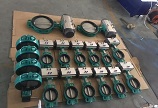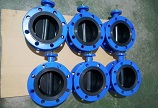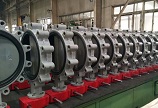24/7 Emergency Service
+86 185 2662 3967
Contact Us Now!
24/7 Emergency Service
+86 185 2662 3967
Contact Us Now!
Sep. 25, 2021
The invention of the butterfly valve has improved processes and applications in various industries. Butterfly valves regulate flow by starting, slowing down or stopping the medium. This introductory guide is intended to familiarise you with what a butterfly valve is, its components and the variations in its design.
A butterfly valve is a mechanism that regulates the flow of material in a large pipe diameter by rotating a quarter turn of a disc.
Some valves are named after their shape, such as ball valves, globe valves, needle valves, etc. The butterfly valve is named after its movement which resembles the wings of a flying aircraft. The stem resembles the body of a butterfly, while the disc moves like the butterfly's wings. The movement of a butterfly valve is similar to the movement of a butterfly's wings moving up and down 90 degrees when landing.
Hanlde Ductile Iron PN16 Lug Type Butterfly Valve
At its most basic level, a butterfly valve consists of a valve flap, seat, body and actuator. Most parts are more than those, but they are essential components of a butterfly valve. And you can follow LIWEIVALUE to see more.
This part is also known as the handle or operator. It controls the extent to which the butterfly valve opens or closes. It is usually a handle that can be moved 90 degrees and you can squeeze the handle to operate the actuator.
The body of a butterfly valve allows it to be connected to pipes and fittings. It is everything around the valve seat and forms a large part of the valve construction.
The seat of a butterfly valve is usually made of some kind of rubber. When the valve is in the closed position, it ensures a tight and secure seal. If a butterfly valve stops functioning properly, the seat has probably been damaged in some way.
The disc is what gives the butterfly valve its name. When the disc is turned, the valve opens, giving the disc a butterfly-like appearance.
Although these valves all essentially perform the same function, there are many variations of butterfly valve design to suit different operations. Below are the three main butterfly valve types.
Zero offset means that there is no offset in the valve stem. The valve is sealed by interference of the stem between the valve flap and the rubber seat along the edge of the valve flap. The rubber-seated valve has the lowest pressure rating and can withstand heat up to 400°F. Its rubber seat wraps around the body to prevent contact with the material that maintains the purity of the media.
This butterfly valve is called double offset because the offset is in two positions: at the line of the seat/body seal and at the bore. The eccentric positioning increases the durability of the seal.
The best type of butterfly valve for use in high pressure systems is the triple offset butterfly valve. The Triple Offset is state of the art, has low emissions and is designed for use in a variety of environments. It is heat resistant to 1200°F and it can withstand pressures up to 1,480 PSI. It is frictionless and long wearing as the metal sealing parts do not come into contact until their final point.
The butterfly valve regulates flow by starting, slowing or stopping the media. The discs open and close with a low torque rotation of 90 degrees for any compatible application. Because they are less costly and lighter, butterfly valves are often preferred over other types of valves. If you are a water treatment provider or water company and need to purchase a butterfly valve, please contact us.
Search Blog
Sep. 08, 2022
Tianjin Liwei Has Professional Valve Production Line
Sep. 07, 2022
Are You Interested in Small Order with Fast Delivery?
Aug. 25, 2022
Keywords

Factory Add.:
No.3 Xintai Road, Jinnan District, Tianjin, China.
Office Add.:
C12 Aliyun Jinnan District, Tianjin, China.
Name: Riven Lee
Mob.: +86 185 2662 3967
E-mail: trading_manager@liweivalve.cn
Name: Ariel Wong
Mob.: +86 186 9809 4027
Name: Kerry Zhang
Mob.: +86 187 2267 7875
Navigation
Products
Leave a Message


